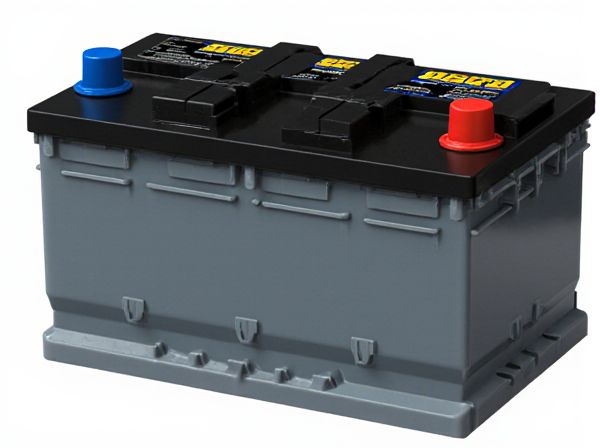
Photo illustration: Thin Plate Pure Lead vs Standard Lead Acid
Thin plate pure lead batteries offer superior charge acceptance and longer cycle life compared to standard lead acid batteries, making them ideal for applications demanding high performance and reliability. Your choice depends on the balance between cost and lifespan, as thin plate pure lead technology typically costs more upfront but reduces maintenance and replacement frequency. Enhanced conductivity and faster recharge rates in thin plate pure lead cells contribute to improved overall efficiency.
Table of Comparison
| Feature | Thin Plate Pure Lead (TPPL) Battery | Standard Lead Acid Battery |
|---|---|---|
| Cycle Life | Up to 1200 cycles | Approximately 300-500 cycles |
| Charge Efficiency | High (95%+) | Moderate (85-90%) |
| Weight | Lighter due to thin plate design | Heavier with thicker lead plates |
| Maintenance | Maintenance-free | Requires regular electrolyte checks |
| Cost | Higher upfront cost | Lower initial cost |
| Performance in High Temperatures | Better heat tolerance | Performance degrades faster |
| Applications | Start-Stop systems, EVs, high-performance vehicles | Conventional vehicles, basic automotive use |
Introduction to Lead Acid Battery Technologies
Thin Plate Pure Lead (TPPL) batteries feature ultra-thin pure lead plates, enhancing charge acceptance and extending cycle life compared to Standard Lead Acid (SLA) batteries which use thicker, alloyed lead plates. TPPL technology delivers higher power density and faster recharge capabilities, making it ideal for deep-cycle and high-demand applications. Standard Lead Acid batteries remain prevalent due to lower cost and established manufacturing processes, but TPPL offers superior performance in modern energy storage solutions.
What is Thin Plate Pure Lead (TPPL)?
Thin Plate Pure Lead (TPPL) batteries feature ultra-thin, pure lead plates that maximize active material surface area, enhancing battery capacity and cycle life compared to traditional Standard Lead Acid batteries. TPPL technology provides superior charge acceptance, faster recharge times, and improved deep cycle durability, making them ideal for high-demand applications such as marine, solar energy storage, and electric vehicles. These batteries deliver higher efficiency and longer lifespan due to reduced sulfation and internal resistance, setting them apart from conventional lead acid counterparts.
Overview of Standard Lead Acid Batteries
Standard lead acid batteries consist of lead dioxide cathodes and sponge lead anodes submerged in sulfuric acid electrolyte, offering reliable energy storage with moderate energy density. These batteries are widely used in automotive starting, lighting, and ignition (SLI) applications due to their cost-effectiveness and robust performance under various temperatures. Their design, while heavier and bulkier compared to Thin Plate Pure Lead (TPPL) batteries, provides a proven balance between capacity, cycle life, and durability.
Key Differences in Construction
Thin Plate Pure Lead (TPPL) batteries utilize ultra-thin lead plates with a higher purity level, enabling increased surface area and enhanced conductivity compared to Standard Lead Acid batteries that use thicker, grid-based lead plates. TPPL construction results in lower internal resistance and improved charge acceptance, which extends cycle life and performance under high rate charging and discharging conditions. Standard Lead Acid batteries typically have a heavier, more robust plate design that sacrifices weight efficiency and fast recharge capability in favor of lower initial manufacturing costs.
Performance Comparison: TPPL vs Standard
Thin Plate Pure Lead (TPPL) batteries offer superior charge acceptance and faster recharge times compared to standard lead acid batteries, making them highly efficient in high-demand applications. TPPL batteries exhibit a longer cycle life with enhanced durability, maintaining performance at higher temperatures and deep discharge levels better than traditional lead acid types. Their low internal resistance supports higher cranking power and more consistent energy output, positioning TPPL as a top choice for premium automotive and industrial uses.
Lifespan and Cycle Durability
Thin Plate Pure Lead (TPPL) batteries offer significantly longer lifespans and higher cycle durability compared to Standard Lead Acid batteries. TPPL technology enables up to 2-3 times more charge-discharge cycles, often exceeding 2000 cycles at 50% depth of discharge, while Standard Lead Acid batteries typically last around 500-1000 cycles under similar conditions. The enhanced purity and thin plate design reduce sulfation and internal resistance, contributing to prolonged service life and consistent performance.
Charging Efficiency and Speed
Thin Plate Pure Lead (TPPL) batteries offer significantly faster charging speeds and higher charging efficiency compared to standard lead acid batteries due to their advanced electrode design and pure lead composition. TPPL batteries exhibit lower internal resistance, enabling rapid charge acceptance and reduced energy loss during charging cycles. This makes TPPL optimal for applications requiring quick recharge and improved energy utilization, enhancing overall battery performance and lifespan.
Maintenance Requirements
Thin Plate Pure Lead (TPPL) batteries exhibit significantly lower maintenance requirements compared to Standard Lead Acid batteries due to their advanced grid design and pure lead plates that minimize corrosion and sulfation. TPPL batteries require less frequent water refilling and exhibit longer service intervals, reducing the need for regular electrolyte checks and maintenance. Standard Lead Acid batteries often demand frequent monitoring and topping up of electrolyte levels to prevent capacity loss and extend overall battery life.
Cost Implications and Value
Thin Plate Pure Lead (TPPL) batteries offer higher initial costs compared to Standard Lead Acid batteries due to advanced materials and manufacturing processes. Despite the premium price, TPPL batteries deliver longer cycle life, faster recharge rates, and improved depth of discharge, resulting in lower total cost of ownership over time. Businesses seeking durable and efficient energy storage solutions find TPPL technology offers superior value by minimizing replacement frequency and maintenance expenses.
Best Applications for Each Battery Type
Thin Plate Pure Lead (TPPL) batteries excel in high-performance applications requiring rapid recharge and deep cycle capabilities, such as UPS systems, telecommunications, and electric vehicles. Standard Lead Acid batteries are best suited for cost-sensitive, low-drain applications like automotive starters and standby power due to their affordability and reliable starting power. The choice depends on balancing performance needs with budget constraints, with TPPL offering superior longevity and efficiency under demanding conditions.
 caratoz.com
caratoz.com